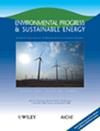下载PDF
{"title":"A study of groundwater matrix effects for the destruction of trichloroethylene using Fe/Pd nanoaggregates","authors":"D.E. Meyer, S. Hampson, L. Ormsbee, D. Bhattacharyya","doi":"10.1002/ep.10334","DOIUrl":null,"url":null,"abstract":"<p>Iron nanoaggregates have been prepared using the sodium borohydride reduction method and postcoated with Pd using aqueous phase electro-deposition. The Fe/Pd nanoaggregates were used to examine dechlorination of trichloroethylene (TCE) with regard to matrix effects using materials representative of a potential zero-valent metal remediation site surrounding the Paducah gaseous diffusion plant in Paducah, KY. A surface-area-normalized first-order rate constant of 1.4 × 10<sup>−1</sup> L m<sup>−2</sup> h<sup>−1</sup> was obtained for the case of ideal dechlorination of 19.6 mg L<sup>−1</sup> TCE at room temperature and pH 6.2 using 0.5 g L<sup>−1</sup> Fe/Pd (0.42 wt % Pd) loading. This value decreases by an order of magnitude to 1.9 × 10<sup>−2</sup> L m<sup>−2</sup> h<sup>−1</sup> when the reaction is carried out in a realistic background matrix when the pH is high (8.8). For all variables tested, Pd content has the most impact on reaction rates. Circulating batch-column experiments are used to study dechlorination under flow conditions and demonstrate the ability of nonstabilized Fe/Pd nanoaggregates to remove significant amounts of TCE (80–90%) over a broad range of groundwater velocities (12.9–83 ft per day) using moderate metal loadings (0.23–0.5 g L<sup>−1</sup>). © 2009 American Institute of Chemical Engineers Environ Prog, 2009</p>","PeriodicalId":11701,"journal":{"name":"Environmental Progress & Sustainable Energy","volume":"28 4","pages":"507-518"},"PeriodicalIF":2.1000,"publicationDate":"2009-11-10","publicationTypes":"Journal Article","fieldsOfStudy":null,"isOpenAccess":false,"openAccessPdf":"https://sci-hub-pdf.com/10.1002/ep.10334","citationCount":"22","resultStr":null,"platform":"Semanticscholar","paperid":null,"PeriodicalName":"Environmental Progress & Sustainable Energy","FirstCategoryId":"93","ListUrlMain":"https://onlinelibrary.wiley.com/doi/10.1002/ep.10334","RegionNum":4,"RegionCategory":"环境科学与生态学","ArticlePicture":[],"TitleCN":null,"AbstractTextCN":null,"PMCID":null,"EPubDate":"","PubModel":"","JCR":"Q3","JCRName":"ENGINEERING, CHEMICAL","Score":null,"Total":0}
引用次数: 22
引用
批量引用
Abstract
Iron nanoaggregates have been prepared using the sodium borohydride reduction method and postcoated with Pd using aqueous phase electro-deposition. The Fe/Pd nanoaggregates were used to examine dechlorination of trichloroethylene (TCE) with regard to matrix effects using materials representative of a potential zero-valent metal remediation site surrounding the Paducah gaseous diffusion plant in Paducah, KY. A surface-area-normalized first-order rate constant of 1.4 × 10−1 L m−2 h−1 was obtained for the case of ideal dechlorination of 19.6 mg L−1 TCE at room temperature and pH 6.2 using 0.5 g L−1 Fe/Pd (0.42 wt % Pd) loading. This value decreases by an order of magnitude to 1.9 × 10−2 L m−2 h−1 when the reaction is carried out in a realistic background matrix when the pH is high (8.8). For all variables tested, Pd content has the most impact on reaction rates. Circulating batch-column experiments are used to study dechlorination under flow conditions and demonstrate the ability of nonstabilized Fe/Pd nanoaggregates to remove significant amounts of TCE (80–90%) over a broad range of groundwater velocities (12.9–83 ft per day) using moderate metal loadings (0.23–0.5 g L−1 ). © 2009 American Institute of Chemical Engineers Environ Prog, 2009
利用铁/钯纳米聚集体破坏三氯乙烯的地下水基质效应研究
采用硼氢化钠还原法制备了铁纳米聚集体,并采用水相电沉积法制备了Pd。在肯塔基州帕迪尤卡市的帕迪尤卡气体扩散厂周围,利用代表潜在零价金属修复场地的材料,利用铁/钯纳米聚集体来检测三氯乙烯(TCE)脱氯的基质效应。在室温和pH 6.2条件下,使用0.5 g L - 1 Fe/Pd (0.42 wt % Pd)负载,得到19.6 mg L - 1 TCE的理想脱氯速率为1.4 × 10 - 1 L m - 2 h - 1的表面积归一化一阶速率常数。当pH值较高(8.8)时,在实际的背景基质中进行反应时,该值降低一个数量级至1.9 × 10−2 L m−2 h−1。在所有测试变量中,钯含量对反应速率的影响最大。循环批柱实验用于研究流动条件下的脱氯,并证明了非稳定铁/钯纳米聚集体在广泛的地下水流速范围内(12.9-83英尺/天)使用中等金属负荷(0.23-0.5 g L - 1)去除大量TCE(80-90%)的能力。©2009美国化学工程师学会环境计划,2009
本文章由计算机程序翻译,如有差异,请以英文原文为准。


